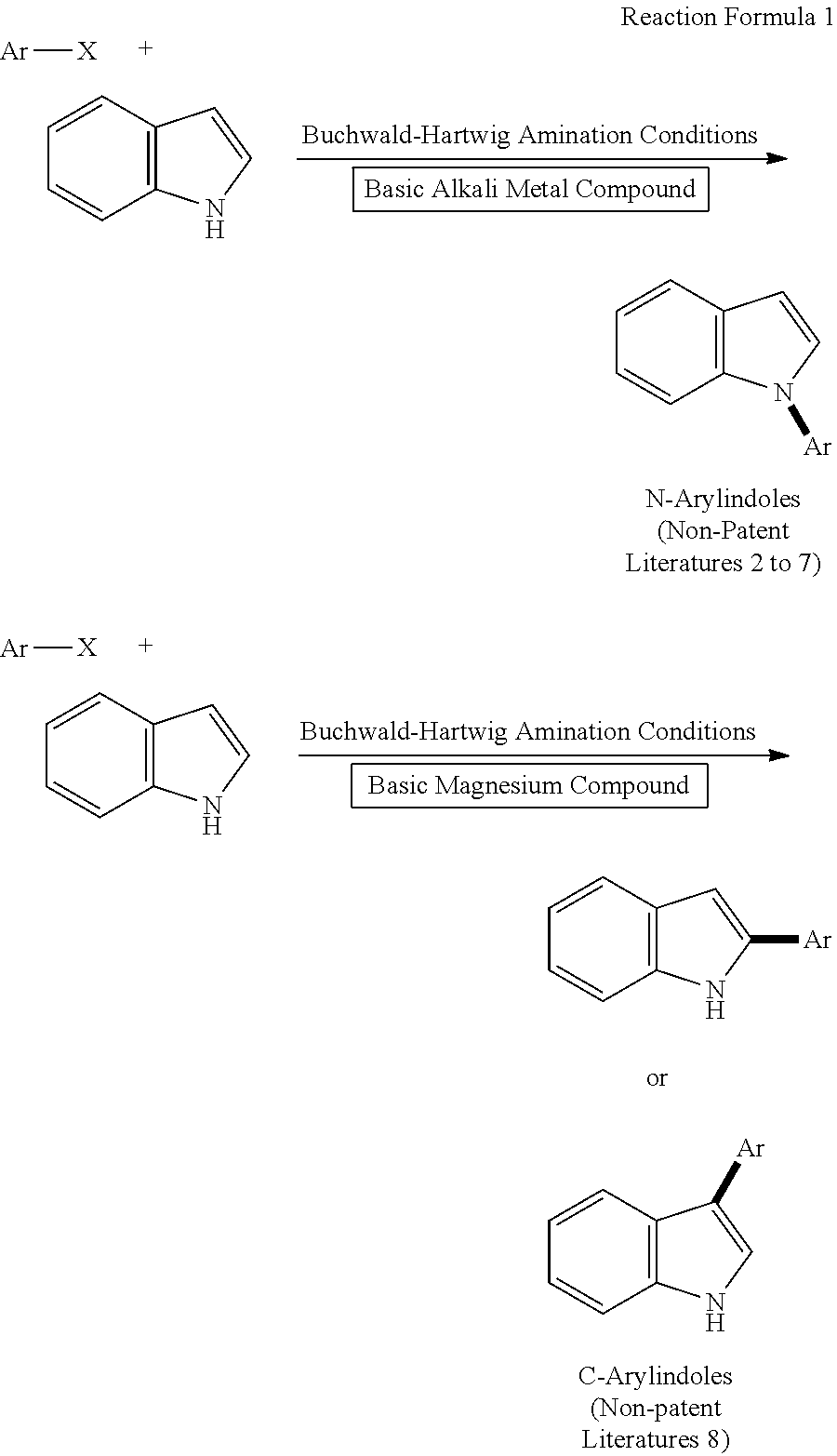Process for producing N-(hetero)arylazoles
a technology of arylazole and arylazole, which is applied in the field of process for producing n(hetero)arylazole, can solve the problems of high cost, poor usefulness of reaction, and high cost of reactive substrates such as (hetero)aryl, and achieves low cost and high efficiency.
- Summary
- Abstract
- Description
- Claims
- Application Information
AI Technical Summary
Benefits of technology
Problems solved by technology
Method used
Image
Examples
example 1
Production of N-(4-methylphenyl)carbazole (Structural Formula (8)) (Reaction Formula 2)
[0111]
[0112]Allylpalladium(II) chloride dimer ([PdCl(π-allyl)]2) (5.8 mg, 0.025 mol %) and di-tert-butyl(2,2-diphenyl-1-methyl-1-cyclopropyl)phosphine (cBRIDP) (22.2 mg, 0.1 mol %) were placed into a 50 mL, two-necked, round bottomed flask equipped a gas inlet, and the flask was evacuated and filled with nitrogen. Subsequently, to the mixture was added dehydrated THF (8.2 mL, 101.0 mmol, 1.6 equivalents), and the mixture was stirred at room temperature for 1 minute to prepare a THF solution of an equivalent mixture of PdCl(π-allyl)(cbridp) and cBRIDP (a catalyst solution) as a pale yellow liquid. Separately, a 200 mL, four-necked, round-bottomed flask equipped with a Teflon® coated magnetic stirring bar, condenser, dropping funnel, thermometer, and a gas inlet was evacuated and filled with nitrogen. Carbazole (10.9 g, 65.0 mmol, 1.03 equivalents) and dehydrated xylenes (66 mL) were charged into th...
example 2
Production of N-(4-methylphenyl)carbazole (Structural Formula (8)) Using di-tert-butyl(2,2-diphenyl-1-methylvinyl)phosphine (vBRIDP) as a Coordination Compound
[0116]The reaction was conducted for 3 hours in the same experimental procedures as in Example 1 except for using vBRIDP (21.4 mg, 0.1 mol %) as a coordination compound, and 15.9 g of N-(4-methylphenyl)carbazole was obtained as a white powder.
[0117]Isolated yield: 98.0%.
example 3
Production of N-(4-methylphenyl)carbazole (Structural Formula (8)) Using 2-di-tert-butylphosphino-2′,4′,6′-triisopropylbiphenyl (tBuXPhos) as a Coordination Compound
[0118]The reaction was conducted for 3 hours in the same experimental procedures as in Example 1 except for using tBuXPhos (26.8 mg, 0.1 mol %) as a coordination compound, and then, 14.3 g of N-(4-methylphenyl)carbazole was obtained as a white powder.
[0119]Isolated yield: 88.1%.
[0120]The results of Examples 1 to 3 are summarized in Table 1.
[0121]
TABLE 1CoordinationIsolatedEx.CompoundReaction TimeYield1cBRIDP1 hr98.5%2vBRIDP3 hrs98.0%3tBuXPhos3 hrs88.1%
[0122]It has become apparent from these results that, in the production process of the invention, various electron-rich, bulky coordination compounds can preferably be used.
PUM
| Property | Measurement | Unit |
|---|---|---|
| temperature | aaaaa | aaaaa |
| bite angle | aaaaa | aaaaa |
| bite angle | aaaaa | aaaaa |
Abstract
Description
Claims
Application Information
 Login to View More
Login to View More - R&D
- Intellectual Property
- Life Sciences
- Materials
- Tech Scout
- Unparalleled Data Quality
- Higher Quality Content
- 60% Fewer Hallucinations
Browse by: Latest US Patents, China's latest patents, Technical Efficacy Thesaurus, Application Domain, Technology Topic, Popular Technical Reports.
© 2025 PatSnap. All rights reserved.Legal|Privacy policy|Modern Slavery Act Transparency Statement|Sitemap|About US| Contact US: help@patsnap.com



